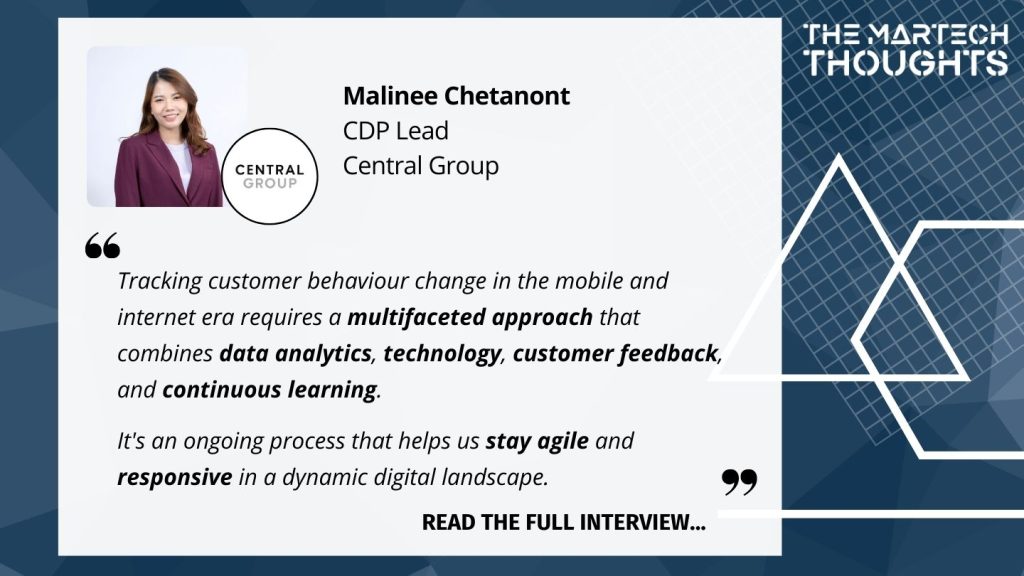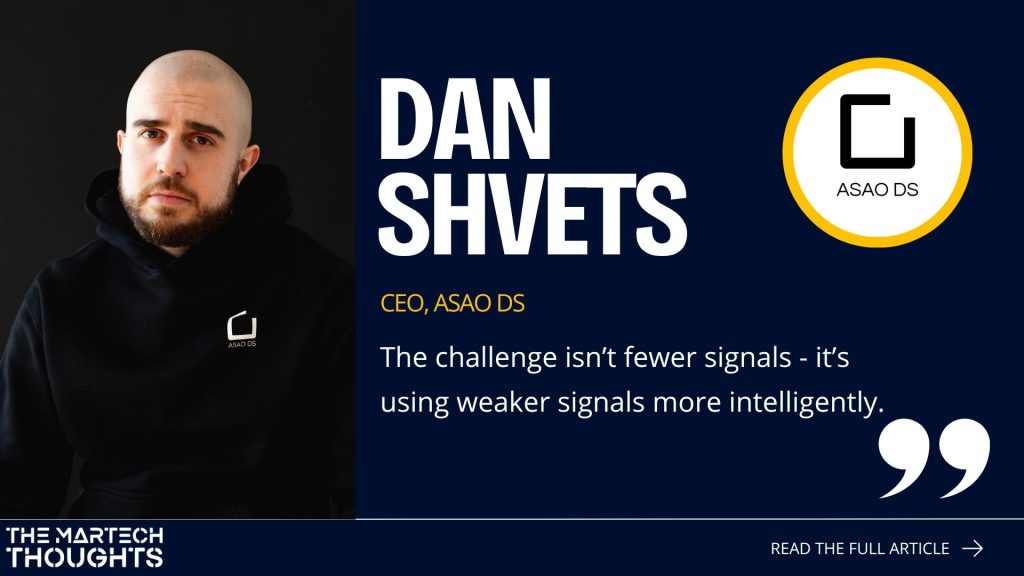
Welcome Malinee Chetanont, CDP Lead, Central Group sharing her insights on Customer Data, Marketing Strategy, & Data-Driven Marketing, as part of the MarTech Thoughts series.
What is your industry? How do you describe your job to a 5-year-old?
My industry falls under the broader category of digital marketing and CRM. In my role as a CDP Lead and Digital MarTech Specialist, I focus on harnessing customer data and technology to improve how businesses connect with their customers in the digital world. This involves everything from analysing customer information to creating effective marketing campaigns that make people interested in what the businesses have to offer.
How would I explain my job to a 5-year-old:
My industry is all about helping businesses understand and make friends with their customers. Imagine I have a magical treasure chest full of information about people who like to buy things from a store. My job is to open that treasure chest, look inside, and find out what those people like and what makes them happy. Then, I share this information with the people who work at the store, so they can do things that make those customers really happy and want to keep coming back to the store. It’s like being a friendly detective who helps stores make their customers smile and come back for more fun shopping!
What is the one marketing platform/app/solution you can’t live without? Why?
One crucial solution I can’t live without is a robust Customer Data Platform. A CDP is like the central brain for all customer information. And why it’s essential:
- Data Integration: A CDP allows me to gather and organise data from various sources, such as websites, mobile apps, email marketing, and social media. It brings all this data together in one place, making it easy to understand and use.
- Customer Insights: With a CDP, I can analyse this data to understand customer behaviour, preferences, and needs. This is invaluable for creating personalised marketing campaigns and improving the customer experience.
- Segmentation: It helps me segment customers into groups based on their characteristics and behaviour. This segmentation is crucial for targeting specific audiences with relevant content and offers.
- Automation: A good CDP often includes automation capabilities. This helps in automating marketing processes, such as sending personalised emails or notifications to customers based on their actions.
- Personalisation: A CDP enables me to personalise marketing efforts on a large scale. I can create personalised product recommendations, content, and offers, which greatly enhance customer engagement and conversion rates.
Customer Data Platform is the foundation for effective digital marketing and customer relationship management. It empowers me to turn data into actionable insights and deliver highly targeted, personalised marketing campaigns that drive results and build strong customer relationships. Without it, managing and utilising customer data effectively would be a significant challenge.
How much of your marketing is data-driven?
Data is the lifeblood of modern marketing, and leveraging it effectively is essential for achieving success in today’s competitive digital landscape.
A substantial portion of our marketing activities is data-driven, as we recognise the critical role data plays in understanding our customers, optimising marketing strategies, and achieving measurable results. Data-driven marketing is not just a part of our approach; it is at the core of how we operate in the digital marketing landscape.
As mobile and internet use rapidly expands; how do you track customer behaviour change?
CDP are central to my role. They allow me to collect, integrate, and analyse customer data from multiple sources, social media platforms are excellent sources for monitoring customer sentiment and emerging trends. Social listening tools help track mentions, hashtags, and discussions related to our brand and industry.
Regarding, cross-channel integration, I ensure that data from various channels, including mobile apps, websites, and social media, is integrated into our analytics platform. This cross-channel data integration enables a holistic view of customer behaviour. Tracking customer behaviour change in the mobile and internet era requires a multifaceted approach that combines data analytics, technology, customer feedback, and continuous learning. It’s an ongoing process that helps us stay agile and responsive in a dynamic digital landscape.
What challenges do you see in processing data coming from different sources? How to overcome?
Processing data from different sources presents several challenges, but with the right strategies and tools, these challenges can be effectively overcome. Managing changes in data sources and schemas over time can lead to data versioning issues, the solution is to implement version control for data sources, and schemas, document changes and maintain historical records of data transformations.
Addressing these challenges requires a combination of technology, data governance practices, skilled data professionals, and a commitment to continuously improve data integration processes. Organisations that effectively process data from different sources gain a competitive advantage by harnessing valuable insights for decision-making and innovation.
With more consumers being conscious of their data being shared, how do you overcome the growing concern?
Clearly communicate how customer data will be used and shared. Use plain language in privacy policies and consent forms.
Obtain explicit consent before collecting and using customer data for marketing purposes. Provide easy-to-access opt-out options for customers who wish to withdraw consent. Educate customers about the benefits of sharing data, such as personalised experiences and tailored recommendations.
Provide resources for customers to learn about data privacy rights and how their data is used. Data Portability and Deletion, offer customers the ability to access, export, or delete their personal data upon request.
Implement processes and tools to facilitate data portability and deletion requests efficiently.
How do you monetise the data/feedback/interactions for future campaigns and alternative growth/revenue channels?
- Segmented advertising, utilises our customer data to create highly targeted advertising campaigns.
- Sell ad space or partner with advertisers to deliver more effective and personalised ad campaigns.
- Affiliate marketing, uses customer behaviour data to identify relevant affiliate marketing opportunities.
- Partner with companies whose products or services align with your customer base, earning commissions on sales or leads generated through referrals.
How to use the data dynamically while creating a seamless physical and digital customer experience?
Create unified customer profiles that consolidate data from various channels. Each profile should provide a 360-degree view of the customer, including their purchase history, preferences, behaviour, and interactions. Maintain a single source of truth for customer data to avoid inconsistencies. Such as data enrichment, and enriching customer profiles with additional data points such as demographic information, social media activity, and transaction history.
Use data enrichment services or tools to supplement existing data with valuable insights. And predictive analytics, utilises predictive analytics and machine learning algorithms to anticipate customer needs and behaviours. These algorithms can provide recommendations for personalised experiences. For example, recommend products or services based on past purchases or browsing history.
What data enrichment strategies can you suggest that work effectively from your experience?
Incorporate data from customer purchase history and transaction records. Analyse past buying behaviour to identify cross-selling and upselling opportunities. Segment customers based on their transaction history for more targeted marketing. Additionally, predictive analytics implements predictive analytics models that leverage existing customer data to make educated predictions about customer behaviour and preferences. These models can help identify potential leads, optimise marketing campaigns, and improve customer retention.
What’s the best advice someone has ever given you?
The best advice I’ve received in my professional journey is to “Embrace Change and Continuous Learning.” This advice has been instrumental in my role as a CDP Lead and Digital MarTech Specialist because the marketing and technology landscape is constantly evolving. The advice to embrace change and continuously learn has helped me excel in my role by keeping me adaptable, innovative, and focused on delivering measurable results in the fast-paced world of digital marketing and MarTech.
A big thank you to Malinee Chetanont, CDP Lead, Central Group sharing her insights on Customer Data, Marketing Strategy, & Data-Driven Marketing.
If you want to connect with Malinee after reading her MarTech Thoughts, please reach out to her via her LinkedIn Profile!
See more MarTech Thoughts interview pieces here!
Last updated: Oct 2023













